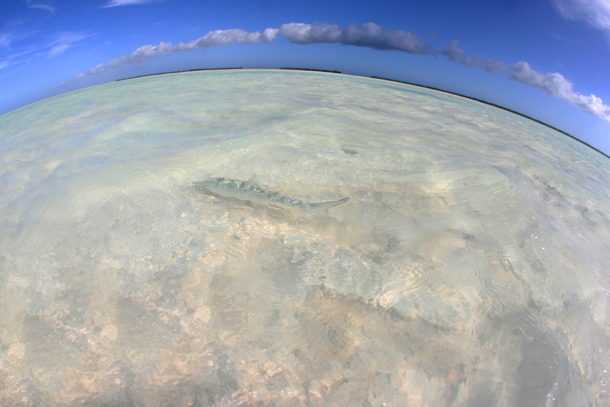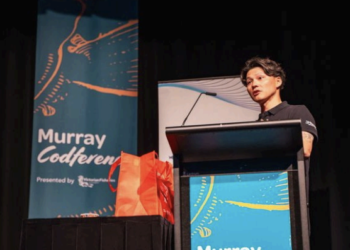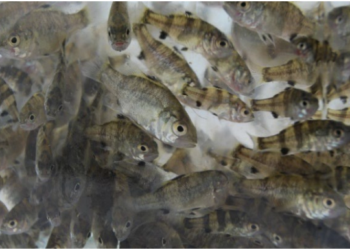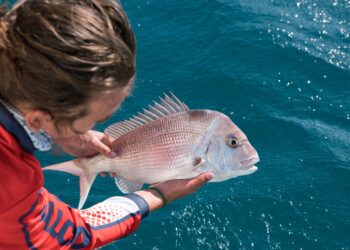For many years, stalking bonefish over brilliant white sand flats and crystal clear shin deep water was something I’d daydreamed about, along with fishing for those bucket mouthed tarpon of the Bahamas and Florida Keys. Thankfully I can now say I’ve done the former, and it was worth the wait.
I’ve just spent a week on Christmas Island, Kiribati, the world’s largest coral atoll situated just over the equator in the South Pacific Ocean, around three hours by plane from Honolulu. On Christmas Island the Ikari reigns supreme. That’s the name the local Gilbertese people have for their much revered bonefish, found there in prolific numbers. While opportunities exist for targeting bigger game fish out on the bluewater surrounding Christmas, the bones that rule its never ending crazy maze of sand flats can quickly have you hooked …
We’d arrived on the island at 6.30am last Wednesday week – Fisho’s Pat Brennan, Scott Thomas and myself, Canberra-based fly fishing quiet achiever Dave Longin, and two other bonefishing first timers in Alex Naoumidis and Graham Dodds – and after a coffee and quick breakfast at our base of Ikari House we were on the water. The first day was reasonably tough as coming off the full moon the bones were still to gather in numbers and cruise the flats. The flats vary in size and make up, with some vast expanses of barren clear white sand, others strewn with massive outcrops of line shredding bone coloured coral. Most have names with a colourful history: Go Like Hell, Smoky, Whisper, Nine Mile, Koito and Paris 1, 2 and 3 to name just a few.


Despite the majority of us having had little sleep in transit to Christmas Island – apart from Pat Brennan who’d been zonked out on sleeping pills – we all managed to catch our first ever bonefish (and more) on day one. It was a great introduction after months of pre-trip expectation and we all slept very well that night.
The preferred method of targeting bonefish is by sight fishing using a 6-8 weight fly rod, floating line and small flies tied to loosely resemble crabs, shrimps, small fish – anything a bonefish might find as it cruises, searching the skinny water, nose down, large forked tail up. Bones will also readily take small soft plastic grubs, but somehow that almost seemed like “cheating” as the fish present a supreme challenge for fly fishers – a fact borne out by a thriving post WW2 US-based bonefishing industry.
Popular flies are Crazy Charlies, Christmas Island Special, George Bush Special in sizes 4, 6 and 8, tied sparsely with a minimum of flash and a variety of colours. Bead chain and lead head eyes are used to get the fly to sink, depending on required depth. In hindsight in preparing for the trip we’d all tied way too many flies as only a couple of colours and weights were needed for consistent results. Accordingly, pre-dinner fly tying over beers became a regular event on the first few nights.
The fishing revolved around four groups of two anglers, with a local guide split up between pairs. Spotting bonefish over the brilliant white Christmas Island flats took some time to come to grips with. While our guides – Ray, Simon, Natan, and later in the week legendary Christmas Island guide English – were well practised in spotting bonefish in all sorts of conditions, a strong prevailing southerly wind and persistent cloud cover presented quite a challenge. As the week went on the numbers of bones we saw gradually increased and our catch and release tally began to soar.


Anyone who has polaroided for trout in lakes or slow flowing rivers will find many similarities in bonefishing. Once you become used to spotting the fish it all starts to fall into place – most of the time. Bones can be differentiated from other fish that occur on the flats such as milkfish, giant and bluefin trevally, surgeon fish, puffers, triggerfish and goatfish, by their colouration. Bones move slowly and deliberately into the wind and are differentiated from other fish by a turquoise tinged back, or more easily spotted by a glistening forked tail waving in the breeze. The sight of a small army of tailing bonefish fish slowly working its way towards you is something not forgotten in a hurry…
Bonefish are aptly known as “the ghost of the flats”. While moving to you head on they can be more easily made out. That quickly changes when a bone decides to take a side-on detour and seemingly disappears before your very eyes! This element definitely adds to the overall challenge of bonefishing.

Casts are usually made 1.5 – 2m ahead of the fish so as not to spook them. This doesn’t always get the required result as some fish are so intent on feeding they need the fly lobbed within centimetres of their nose before they acknowledge it.
Once your fly is cast out you often have to wait until the fish is close enough before doing a sharp long pull on the line to get its attention. “Long strip … wait … long strip…wait … short strip, short strip … ” is a common call when fishing with a guide. Bones commonly show different levels of interest in your fly: some charge over and eat it as it sinks, others require a series of long strips followed by short, sharp tugs to suck them in. Others come and look at your fly and can’t get away from it fast enough! Whether or not a bone eats your fly, seeing the whole play unfold before your eyes makes this form of fishing very addictive.


The making tide is usually the best as bonefish gather in numbers and make their way up onto the flats from deeper water. They are often hungry at this time or as the guides describe it, “angry”. In contrast to the bottom of the tide when bones are skittish and spooky and can baulk at a raised rod or a clumsy step, the fish spotted on the making tide often charge flies and eat them with gusto.
If you’ve ever read anything about bonefishing you’ll know the fish are renowned for a spirited fight. This is definitely the case and the bigger the bone, the more drawn out and spectacular the fight. Even small bones can pull out your whole fly line and take you into the backing, but the bigger fish are a whole other story. We all experienced the line burning runs of big bones, or crazy bust-offs as loose loops of line grabbed anything in its way as it shot through rod runners as a fish lit the afterburners.
A couple of six pounders landed on the trip will live long in my memory. The second I’d spotted as it cruised with two similar sized fish in about a foot of water. After feeling the hook it roostertailed past me and kept on for about 200 metres across the flat and out into the deeper water of the channel. Pat Brennan offered to take some photos but unfortunately the fish put a halt to his fishing for the next 20 minutes as it refused to give in, taking the reel well into the pink Bionic Braid backing four times or more.


There are many, many highlights that come with a week’s fishing on Christmas Island. Apart from bonefish there are mega-sized GTs lurking along the edges of the flats and over coral reefs. Manta rays glide and dance in schools while large black tipped reef sharks keep you company from a distance as you stalk the flats. We saw huge yellowfin tuna busting into baitfish 100m from shore in the late afternoon sun as we took time out from bonefishing to throw some poppers around. Wahoo, dogtooth, sailfish and other gamefish can be readily caught outside of the island in calm weather. While there are plenty of fishing options available at Christmas Island it is difficult to go past those magical bonefish. Now for those tarpon…

For a full feature on Christmas Island’s bonefishing stay tuned to Fishing World magazine.
For info on planning a Christmas Island bonefishing trip contact: ikarihouse@yahoo.com





















